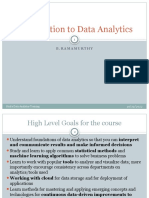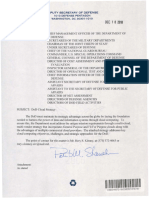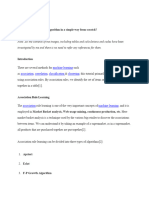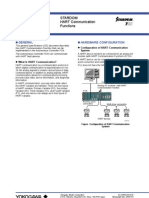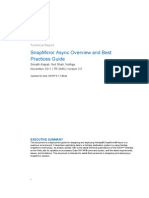Solution Path For Implementing A Comprehensive Architecture For Data and Analytics Strategies
Uploaded by
rainworm99Solution Path For Implementing A Comprehensive Architecture For Data and Analytics Strategies
Uploaded by
rainworm99Solution Path for Implementing a
Comprehensive Architecture for Data and
Analytics Strategies
Downloadable Figures
Carlton Sapp
CONFIDENTIAL AND PROPRIETARY
This presentation, including any supporting materials, is owned by Gartner, Inc. and/or its affiliates and is for the sole use of the intended Gartner audience or other intended recipients. This presentation may contain information that is
confidential, proprietary or otherwise legally protected, and it may not be further copied, distributed or publicly displayed without the express written permission of Gartner, Inc. or its affiliates. © 2018 Gartner, Inc. and/or its affiliates.
All rights reserved.
Figure 1
How Can I Build a Holistic Data Management Architecture to Support Business Intelligence and
Advanced Analytics?
"EIM 1.0: Setting Up "Enabling Streaming "Adopt the Logical Data "Solution Path for "Create a Data Reference "Making Machine Learning
Enterprise Information Architectures for Warehouse Architecture Planning and Architecture to Enable a Scalable Enterprise
Management and Continuous Data and to Meet Your Modern Implementing the Logical Self-Service BI" Reality — From
Governance" Events" Analytical Needs" Data Warehouse" Development to Production"
1. Enterprise Information 2 Acquire and 3. Enable for 4. Enable Business 5. Extend and Automate 6. Deploy and Integrate
intelligence and advanced analytics capabilities? Management Organize Analytics Insights With AI/ML Into Operations
management architecture to support business
How can I build and maintain a holistic data
1.1 Information 2.1 Ingest and
Governance Analyze 4.1 Business 6.1 Analytic
3.1 Data 5.1 Real-Time
1.2 Master Intelligence Deployment
Warehouse Analytics
Data and Visualization Architectures
Management
1.3 Enterprise
Metadata 2.2 Process 3.2 Data 3.3 Data 5.2 Machine
Management and Transform Lake Virtualization 4.2 Self-Service Learning
Data 6.2 Points of
Preparation Integration for
and Analytics Analytic Systems
1.5
1.4 Data Information
Quality Life Cycle
Assurance Management 2.3
Integrate 4.3 5.3 Automate
Advanced 6.3 Model
1.6 Privacy and Store 3.4 Logical Data and Scale Deployment for
and Security Warehouse Analytics
Data Scientists
Continuous Align With Governance People Account for Agile Database Cloud Versus
Improvement Business Strategy and Skills Citizen Roles Development On-Premises
"Enable Essential Data "Applying Effective Data "Implement Agile Database "Migrating Enterprise
Governance for Successful Big Governance to Secure Development to Support Your Databases and Data to
Data Architecture Deployment" Your Data Lake" Continuous Delivery Initiative" the Cloud"
ID: 351281 © 2018 Gartner, Inc.
1 © 2018 Gartner, Inc. and/or its affiliates. All rights reserved.
Figure 2
An End-to-End Data Reference Architecture
Acquire Organize Analyze Deliver
Data Sources
Streaming/In Motion
LOB Apps Analytic
Policy Orchestration Deployment
Stream Ingestion RT Algorithm
IT Log IoT Feeds
Streaming Real Time
Video API High-Performance Ingestion
RT Integration Message Traditional Interact
Image Audio Broker Queue Reporting
Device
IoT Self-Service Pub/Sub
Staging/At Rest Platform Data Analytic Smart Data
Capabilities Discovery
Preparation/
Operational Systems Data Access
Analyze
Distributed
Logical Data Warehouse Columnar Optimize Visual
Embed
Layer Forecast
Exploration
Other NoSQL Data
Distributed Storage/
Process In-Memory Report Analytic
Data Management
NoSQL NoSQL Temporary Plan Dashboards
API Integration Virtualization NoSQL Data Discover App
Other IMDB Storage API
Transform SQL Other/Hadoop Services Collaborate Storytelling/
Narrative
Centralized/Monolithic Aggregate Market- Predict
Automate
SQL RDBMS place or Model
Datasets Advanced Enrich
Analytics Data
ERPs API Store
Doc Image Feeds Administration
Video Text IT Log
External
Manage and Govern = Optional
Information Governance (Including Metadata Management, Data Quality, Data Modeling, Master Data Management), = Cloud, On-Premises
Data Management (Data Admin., Security, Privacy and Identity) and Organization (People) or Hybrid
ID: 351281 © 2018 Gartner, Inc.
2 © 2018 Gartner, Inc. and/or its affiliates. All rights reserved.
Figure 3
EIM Components and Their Relationship to
Information Governance
Metadata
Management
Information
Master Data
Lifecycle
Management
Management
Information
Governance
Privacy and Data Quality
Security Management
ID: 351281 © 2018 Gartner, Inc.
3 © 2018 Gartner, Inc. and/or its affiliates. All rights reserved.
Figure 4
EIM and Information Governance Creates a Virtuous Cycle
Governance Compliance
Value Protection
Insights Trust
Findability
ID: 351281 © 2018 Gartner, Inc.
4 © 2018 Gartner, Inc. and/or its affiliates. All rights reserved.
Figure 5
Social Metadata — The Tip of the Metadata Spear
Social
▪ Specialist insight
▪ Tribal knowledge
▪ Usage tips
▪ Context and veracity
Business
▪ Definitions
▪ Quality rules
▪ Integration rules
▪ Usage rules
Technical Operational
▪ Data model ▪ Lineage
▪ Type ▪ Quality
▪ Format ▪ Provenance
▪ Structure
ID: 351281 © 2018 Gartner, Inc.
5 © 2018 Gartner, Inc. and/or its affiliates. All rights reserved.
Figure 6
Application and Data Security Overview
Cloud
Security
and Emerging
Technology
Security
Threat and Applications ▪ Data security governance
Vulnerability and Data defines policies and controls
Management IAM and Security
Security ▪ Data is pervasive; data
Team security must be too
▪ Data residency and hacking
are top risks
Security
Endpoint and
Monitoring
Mobile ▪ Application security testing
and is critical
Security
Operations
Network and
Gateway
Security
ID: 351281 © 2018 Gartner, Inc.
6 © 2018 Gartner, Inc. and/or its affiliates. All rights reserved.
Figure 7
Data and Analytics Architecture — Acquire and Organize
Acquire Organize Analyze Deliver
Data Sources
Streaming/In Motion
LOB Apps
Policy Orchestration
Stream Ingestion RT Algorithm
IT Log IoT Feeds
Real Time
Streaming
Video API
RT Traditional Interact
Image Audio Reporting
Device
Message High-Performance Pub/Sub
Broker Ingestion Strategy Self-Service
Analytic Smart Data
Staging/At Rest Data
Capabilities Discovery
Preparation/
Operational Systems Data Access Analyze
Logical Data Warehouse Layer Optimize Visual Embed
Distributed Columnar
Forecast Exploration
Other NoSQL Traditional Distributed Storage/
Data Process In-Memory Report
NoSQL NoSQL Management Temporary Plan Analytic
Data Dashboards App
Virtualization NoSQL Storage
Other IMDB API Integration Discover API
Transform SQL Data Collaborate
Other/ Storytelling/
Centralized/Monolithic Aggregate Hadoop Services Predict
Market- Narrative Automate
SQL RDBMS Model Enrich
place or Data
Datasets Store
Advanced
ERPs API
Analytics
Image Feeds Message
Doc
Queues Administration
Video Text IT Log
Evolving Into IoT
External Platforms
Apps
ID: 351281 © 2018 Gartner, Inc.
7 © 2018 Gartner, Inc. and/or its affiliates. All rights reserved.
Figure 8
Data and Analytics Architecture — Store and Enable
Acquire Organize Analyze Deliver
Data Sources
Streaming/In Motion
LOB Apps
Policy Orchestration
Stream Ingestion RT Algorithm
IT Log IoT Feeds
Real Time
Streaming
Video API
RT Traditional Interact
Image Audio Reporting
Device
Message High-Performance Pub/Sub
Broker Ingestion Strategy Self-Service
Analytic Smart Data
Staging/At Rest Data
Capabilities Discovery
Preparation/
Operational Systems Data Access Analyze
Logical Data Warehouse Layer Optimize Visual Embed
Distributed Columnar
Forecast Exploration
Other NoSQL Traditional Distributed Storage/
Data Process In-Memory Report
NoSQL NoSQL Management Temporary Plan Analytic
Data Dashboards App
Virtualization NoSQL Storage
Other IMDB API Integration Discover API
Transform SQL Data Collaborate
Other/ Storytelling/
Centralized/Monolithic Aggregate Hadoop Services Predict
Market- Narrative Automate
SQL RDBMS Model Enrich
place or Data
Logical Data Lakes Datasets
Advanced Store
ERPs API
Internal External Data Science Analytics
Image Feeds Message Data Lake Data Lake Data Lake
Doc
Queues Administration
Object
Video Text IT Log Cloud Stores
External
Apps
ID: 351281 © 2018 Gartner, Inc.
8 © 2018 Gartner, Inc. and/or its affiliates. All rights reserved.
Figure 9
The LDW Conceptual Architectural Diagram
Analytical Clients
Descriptive Diagnostic Predictive Prescriptive
Logical Data Warehouse
Semantic Management
Management
Metadata
Repository Virtualization Distributed Process
Data Integration Layer
Data Sources
Social Image Text Feeds Video Audio IT Log
Streaming RDF RDBMS HDFS ERPs Doc
ID: 351281 © 2018 Gartner, Inc.
9 © 2018 Gartner, Inc. and/or its affiliates. All rights reserved.
Figure 10
The LDW Architecture
Key Question: "What are we building?"
Company Strategy
Business Processes
Operational Query and Reporting Standard and Self-Service Reporting/ Data Science, AI, Machine Learning,
APIs
Reporting Ad Hoc Data Sourcing Statistical, Predictive
Metadata/Model, Governance, Change Control
LDW Noncore ODS DW Platforms Nonrelational Platforms
Systems Platform Virtual Marts
Other DB
Access/Virtualization/Federation
Remote & Third- ODS DW Marts Data Lake
Party Systems Graph,
(Not Just Hadoop) Document,
Legacy DWs Sandboxes Sandboxes …
Staging
Security
Infrastructure Platforms And/Or
On-Premises Servers (Compute) Cloud Servers (Compute)
Node Node Node Node Node Node Node Node Node Node Node Node
Hot Data Storage Hot Data Storage
Cool Data Storage Cool Data Storage
Ingest: ETL, ELT, Replication, Streaming, Business, Rules Streaming Analytics
Key Queryable Process Governance Source Source Source Source Source Source Source
Ingest Platform HTAP HTAP HTAP
ID: 351281 © 2018 Gartner, Inc.
10 © 2018 Gartner, Inc. and/or its affiliates. All rights reserved.
Figure 11 Business Analytic Reference Architecture — From Data to
Insight to Action
Analytic Output
Artifacts Options
Analytic Traditional
Capabilities Reporting
Interact
Device
Analyze
Optimize
Self-Service Smart Data
Data Source Connectors
Data Discovery
Preparation/ Forecast
Data Access
Layer Columnar Report
Storage/
In-Memory Plan Visual
Temporary Exploration Embed
Storage Discover
Data App
Services — Collaborate Analytic
Marketplace Dashboards
or Datasets Predict
Model Automate
Storytelling/
Narrative
Enrich Data
Store
Administration Advanced
Analytics
ID: 351281 © 2018 Gartner, Inc.
11 © 2018 Gartner, Inc. and/or its affiliates. All rights reserved.
Figure 12
The Basics of Machine Learning Technology
Input Data "Training" Output Data
Machine Learning (a
Data-Driven Approach)
Feed Machine Learning Align Appropriate Type of Present Results Based on
Various Data Machine Learning Data
(e.g., structured Algorithm (e.g., exploratory, predictive
and unstructured) (e.g., supervised and classification)
and unsupervised)
ID: 351281 © 2018 Gartner, Inc.
12 © 2018 Gartner, Inc. and/or its affiliates. All rights reserved.
Figure 13
Machine Learning Architecture
Data Processing
(Feature Engineering)
Processing Engine
Transform- Normal- Cleaning
Data ation ization and
Acquisition Encoding Execution Deployment
Data
Ingestion
ERP
Databases
Stream Preprocessing Sample Training/
Processing Data Selection Testing Set
Platform
Experimen- Testing Tuning
Mainframe tation
Model
Batch Data Engineering
IoT Warehouse
Devices Data
Machine Storage
Algorithms
Clustering Learning
Algorithm Algorithm Execution
ID: 351281 © 2018 Gartner, Inc.
13 © 2018 Gartner, Inc. and/or its affiliates. All rights reserved.
Figure 14
End-to-End ML and Analytics Architecture
ACQUIRE ORGANIZE ANALYZE DELIVER
Data Sources Processing and Data Preparation
Streaming/In Motion LOB Apps
Feature
Engineering Policy Orchestration
Messaging Stream
Ingestion Includes feature
IT Log IoT Feeds Protocols Cleaning and
Real Time Transformation Normalization extraction and
Encoding
feature
Streaming API transformation
Video R/T Execution and Operationalizing
Experiment Test Tune Traditional
Reporting Interact
Image Audio Device
IoT Platform PUB/
Preprocessing Sample Training/ Analytic
Staging/At Rest Data Selection Testing Set SUB
Capabilities
Operational Systems Self-Service Smart Data
Data Analyze Discovery
Distributed
Preparation/
NoSQL Data Data Access
Other Optimize
Modeling Layer
Visual
NoSQL NoSQL Forecast Exploration
Model
Engineering Columnar Embed
Other IMDB Storage/ Report
Includes model
fitting and model In-Memory
Clustering Learning Analytic
Centralized/Monolithic evaluation Temporary Plan
Algorithm Algorithm Dashboards
API Storage App
SQL RDBMS API
Discover
Logical Data Warehouse
ERPs Data Data Storytelling
Collaborate Automate
Integration Traditional Distributed Process Services – /Narrative
Image Feeds Transform Data Marketplace
Doc Aggregate Virtualization or Datasets Predict
Management Other/ Enrich
NoSQL Data
SQL Hadoop Model Advanced Store
API
Video Text IT Log Analytics
External Administration
Manage and Govern = Optional
Information Governance (including Metadata Management, Data Quality, Data Modeling, Master Data Management), Data Management (Data Admin, Security, Privacy and
Identity), Organization (People) = Cloud, On-Premises or Hybrid
ID: 351281 © 2018 Gartner, Inc.
14 © 2018 Gartner, Inc. and/or its affiliates. All rights reserved.
Figure 15
Taxonomy for AI Services
▪ Computer vision APIs ▪ Predictive analytics with ML
▪ Language processing APIs ▪ Platform/Infra services for data
Machine scientists (PaaS/ IaaS)
▪ Speech APIs AI Services Learning
▪ CRM AI APIs Services ▪ Python distribution services
(Anaconda)
▪ ML Pkgs (Spark MLlib)
Compute
▪ AutoML (DataRobot)
R Distribution
▪ Decision engines Expert Systems ▪ Archive network service
Services
(Insight Engines)
▪ Intelligent search (CRAN, MRAN) ▪ R distribution services
▪ Knowledge- ▪ Package managers
based systems
Quantitative
ID: 351281 © 2018 Gartner, Inc.
15 © 2018 Gartner, Inc. and/or its affiliates. All rights reserved.
Figure 16
Example of Connecting to Data Versus Collecting It
Execution
in-database
Connecting
Store procedure
contains Python
code that executes
in-database
Stored Procedure Call (R)DBMS
Application
Results
Server
ML Services
Python Runtime
ID: 351281 © 2018 Gartner, Inc.
16 © 2018 Gartner, Inc. and/or its affiliates. All rights reserved.
Figure 17
Key Drivers for MLaaS
Built-In Reliability Established Uniformity Consistent Reproducibility
Trust Dealing With Diversity Managing Complexity
▪ Can we rely on the ▪ Will it support diverse ▪ Can we reproduce
technology? business objectives? the output?
▪ Can we trust the output ▪ Will it easy interoperate ▪ Can we consistently monitor
being produced? with diverse and manage results?
▪ Do we have what we need technology platforms? ▪ Can we quickly scale?
when need it? ▪ Will it help me homogenize
or consolidate my
technology stacks?
ID: 351281 © 2018 Gartner, Inc.
17 © 2018 Gartner, Inc. and/or its affiliates. All rights reserved.
Figure 18
Integration Points for Various Analytics
Events and Alerts
Self-service Deliver
Acquire Organize Analyze
Analytics
Data Sources
Streaming/In Motion
LOB Apps
Push-method
Stream Policy Orchestration analytics
IT Log IoT Feeds Enterprise Analytics
Ingestion RT Algorithm
Streaming
Video API Real Time
RT Traditional Interact
Image Audio Reporting
IoT Self-Service Device
Pub/Sub
Staging/At Rest Platform Data Analytic Smart Data
Capabilities Discovery
Preparation/
Operational Systems Data Access
Analyze
Distributed
Logical Data Warehouse Columnar Optimize Visual
Embed
Layer Exploration
Distributed Storage/ Forecast
Other NoSQL Traditional Report
Process In-Memory Analytic
Data Data
NoSQL NoSQL Temporary Plan Dashboards
Virtualization Management NoSQL App
Other IMDB API Integration Data Storage Discover API
Transform SQL Other/Hadoop Services Collaborate Storytelling/
Narrative
Centralized/Monolithic Aggregate Market- Predict
Automate
SQL RDBMS place or Model
Datasets Advanced Enrich
Analytics Data
ERPs API Store
Image Feeds Administration
Doc
Video Text IT Log
External
Manage and Govern = Optional
Information Governance (Including Metadata Management, Data Quality, Data Modeling, Master Data Management), = Cloud, On-Premises
Data Management (Data Admin., Security, Privacy and Identity) and Organization (People) or Hybrid
ID: 351281 © 2018 Gartner, Inc.
18 © 2018 Gartner, Inc. and/or its affiliates. All rights reserved.
Figure 19
Traditional Analytic Provisioning
IT often re-engineers
the analytic models New capabilities,
Portability? How do
What do I need to to support application such as AI/ML can
I part the analytic
prep my analytic integration or to overwhelm your
enhance performance across multiple
for deployment? existing operational
(e.g., embedded architectures?
environments
anayltics)
Explore and Predeployment Productionizing Scaling the Monitoring and
Discover Handoff the Analytic Analytic Maintenance
The search for The first phase Getting the How do we How do we
business thru of deploying the model integrated scale the improve
exploratory analytic model into the analytic model the analytic
analysis production in production or iterate
and discovery environment over time?
Changes that need to be
made based on frequent
updates to analytical models
ID: 351281 © 2018 Gartner, Inc.
19 © 2018 Gartner, Inc. and/or its affiliates. All rights reserved.
Figure 20
Target Analytic Provisioning Model
Explore and Predeployment Productionizing Scaling the Monitoring and
Discover Handoff the Analytic Analytic Maintenance
The search for The first phase Getting the How do we How do we
business thru of deploying the model integrated scale improve
exploratory analytic model into the the analytic the analytic
analysis production model in or iterate
and discovery environment production? over time?
Integrated Analytic/
Processing Engines
Model Interchange Model Interchange Embedded
Format Standards Executes code Format Standards Analytic Model
associated with
analytic models
ID: 351281 © 2018 Gartner, Inc.
20 © 2018 Gartner, Inc. and/or its affiliates. All rights reserved.
Figure 21
Aligning Business Strategy With Development
Bottom-Line and
Stakeholders Outcomes Other Results
Performance Feedback on
Executives
Metrics Strategy
Process Business Process Metrics Efficiency and
Owners (Process, Task, Data) Effectiveness
Data and
Information Data Metrics Business
Stewards (Process, Task, Data)
Data Quality
Stakeholder Level Focus
Make the Connection to the Business
ID: 351281 © 2018 Gartner, Inc.
21 © 2018 Gartner, Inc. and/or its affiliates. All rights reserved.
Figure 22 Information Governance — Stages
Awareness
▪ Promote visibility
▪ Training
▪ Auditing and reporting
Compliance
▪ Regulatory compliance
▪ Corporate policies and procedures
▪ IT policies and procedures
Information Profiling
▪ Data inventory and analysis
▪ Data quality, veracity
▪ Lineage and provenance
Privacy and Security
▪ Information classification
▪ Privacy management
▪ Role-based access controls
Information Life Cycle
▪ Retention policy
▪ Hot, warm, cold – tiered storage
▪ Archival
ID: 351281 © 2018 Gartner, Inc.
22 © 2018 Gartner, Inc. and/or its affiliates. All rights reserved.
Figure 23
Example Team Structure for Building an LDW
Key Question: "Who builds the LDW?" Governance Council
Program Manager Chief Data Officer BICC (Evolves From
Development) Business Units
IT/Business (CDO) Business Business Units
Business Units
DW Project Manager IT/Business Lake Team "Citizen
‘Citizen Analysts’
‘Citizen Analysts’
Analysts"/
Power Users
Central Solution Team (Server, Cloud) Data
Data In Team Information Out Team
Scientist IT/
Business ‘CitizenAnalysts’
‘Citizen Analysts’
‘Citizen Integrators’
IT Architect (e.g., Data,
ETL Developer Business Analyst Application, Infrastructure Architect
ETL Developer (Requirements) and Security Architects) IT
and Developer
ETL integrator IT Business Analytics DataScientists
Scientist
and integrator IT Business Data
and Integrator IT IT/Business
Migration Specialist Dev/Build
Data Stewards
Data Modeller Operations Planning Report/Analysis Admin/
Report/Analysis Business
IT/Business Developers
Report/Analysis Monitoring
Developers
Platforms, Including Developers
Appliances, Cloud, …
Virtualization
Information
Business Architect
Self-Service Governance
Virtualization Architect Intelligence Manager
Enablement
Specialist IT or
Business
Database Administrators
Infrastructure, Cloud, App Key DW Agile Lake Governance
ID: 351281 © 2018 Gartner, Inc.
23 © 2018 Gartner, Inc. and/or its affiliates. All rights reserved.
Figure 24 Cloud Deployment Options for Data
On-Premises
Client’s Own Data Center Private Cloud
This is the traditional option, but it can tie Unlike public cloud, the infrastructure is
business down into processing and maintaining dedicated to a single organization. This can
infrastructure and paying the associated costs. help meet certain needs such as strong security
It is best-suited for data needs that are well- control. Private clouds can also be hosted at an
understood and predictable or are governed external provider. These are best-suited for
by stringent regulations. mission-critical applications that have very high
security and uptime requirements.
Public
IaaS BDaaS
Provides clients full control of deploying This provides clients with access to an already-
their data stores(s) in public cloud. This also installed data store that clients can configure to
reduces some of the infrastructure overhead their needs. The advantage of this option is that
but still requires operating system and data businesses don’t need to procure and manage
store skills. infrastructure, and they don’t need to invest in
the corresponding skills. Cloud providers use
multitenancy, in which multiple clients use the
same data store in the public cloud but have a
clear separation of data.
ID: 351281 © 2018 Gartner, Inc.
24 © 2018 Gartner, Inc. and/or its affiliates. All rights reserved.
You might also like
- Introducing qualitative research a student s guide Second Edition Barbour - The ebook with rich content is ready for you to download100% (1)Introducing qualitative research a student s guide Second Edition Barbour - The ebook with rich content is ready for you to download55 pages
- A_Blueprint_for_Modernizing_Support_778434_ndxNo ratings yetA_Blueprint_for_Modernizing_Support_778434_ndx19 pages
- Gartner Research Digital Infrastructures Emerge 2018No ratings yetGartner Research Digital Infrastructures Emerge 20189 pages
- Gartner Catalyst Conference Us Research Note Data Analytics Planning Guide 2018No ratings yetGartner Catalyst Conference Us Research Note Data Analytics Planning Guide 201832 pages
- 2022 Data and Analytics Service ProvidersNo ratings yet2022 Data and Analytics Service Providers48 pages
- Generative AI Revolutionizing Healthcare and Life SciencesNo ratings yetGenerative AI Revolutionizing Healthcare and Life Sciences16 pages
- Data Governance Your Number One PriorityNo ratings yetData Governance Your Number One Priority15 pages
- Forrester White Paper The CIO Guide To Big Data ArchivingNo ratings yetForrester White Paper The CIO Guide To Big Data Archiving27 pages
- FundamentalsOfDesigningDW MelissaCoatesNo ratings yetFundamentalsOfDesigningDW MelissaCoates87 pages
- Accenture Where The Cloud Meets RealityNo ratings yetAccenture Where The Cloud Meets Reality32 pages
- Four - Scenarios - For - How - Cios Can Clarify or Deduce Their Business StrategiesNo ratings yetFour - Scenarios - For - How - Cios Can Clarify or Deduce Their Business Strategies11 pages
- Magic Quadrant For Enterprise IntegrationNo ratings yetMagic Quadrant For Enterprise Integration15 pages
- Gartner - Solution - Path - For - Planning - A - 320563No ratings yetGartner - Solution - Path - For - Planning - A - 32056388 pages
- Consulting Whitepaper Next Generation Application Portfolio Rationalization 09 20110% (1)Consulting Whitepaper Next Generation Application Portfolio Rationalization 09 201119 pages
- Gartner - White - Paper - IT Operations Management 2020 - Shift To SucceedNo ratings yetGartner - White - Paper - IT Operations Management 2020 - Shift To Succeed15 pages
- Rethink Technology in The Age of The Cloud WorkerNo ratings yetRethink Technology in The Age of The Cloud Worker13 pages
- InDEA 2 - 0 Report Draft V6 24 Jan 22 - Rev100% (1)InDEA 2 - 0 Report Draft V6 24 Jan 22 - Rev98 pages
- 2024 IDMC Security Architecture WhitepaperNo ratings yet2024 IDMC Security Architecture Whitepaper22 pages
- Advanced Technology Stacks and Business Use-Cases100% (1)Advanced Technology Stacks and Business Use-Cases28 pages
- DATAVERSITY Erwin State of Data Governance 2020 Final 012420No ratings yetDATAVERSITY Erwin State of Data Governance 2020 Final 01242016 pages
- Use Adaptive Sourcing To Drive Double Digit Cost Optimization of It and Business ProcessesNo ratings yetUse Adaptive Sourcing To Drive Double Digit Cost Optimization of It and Business Processes14 pages
- Best Practices For Implementing Cloud Data Governance and CatalogNo ratings yetBest Practices For Implementing Cloud Data Governance and Catalog45 pages
- Data Governance & IT's Increasing ImportanceNo ratings yetData Governance & IT's Increasing Importance8 pages
- Download_How_to_Define_Build_and_Operationalize_a_Data_FabricNo ratings yetDownload_How_to_Define_Build_and_Operationalize_a_Data_Fabric51 pages
- DataGyan-Data Governnace & DQ FrameworkNo ratings yetDataGyan-Data Governnace & DQ Framework14 pages
- Magic Quadrant For Privileged Access Management 2024No ratings yetMagic Quadrant For Privileged Access Management 202441 pages
- The Forrester Wave™ - Privacy Management Software, Q1 2020 PDFNo ratings yetThe Forrester Wave™ - Privacy Management Software, Q1 2020 PDF18 pages
- L. - A - Good - Information - Management Strategy Starts With Vision and ValuesNo ratings yetL. - A - Good - Information - Management Strategy Starts With Vision and Values10 pages
- 2410 Magic Quadrant For File and Object Storage PlatformsNo ratings yet2410 Magic Quadrant For File and Object Storage Platforms23 pages
- Digital Outcome Driven Metrics For ManufacturingNo ratings yetDigital Outcome Driven Metrics For Manufacturing8 pages
- How To Build A Self-Service Data Analytics Stack Final - Google Docs PdxuleNo ratings yetHow To Build A Self-Service Data Analytics Stack Final - Google Docs Pdxule12 pages
- Continuous Application Modernization and GovernanceNo ratings yetContinuous Application Modernization and Governance20 pages
- 2015 Magic Quadrant For Operational Database Management SystemsNo ratings yet2015 Magic Quadrant For Operational Database Management Systems17 pages
- Bimodal - Raising Everyone's Game For Digital BusinessNo ratings yetBimodal - Raising Everyone's Game For Digital Business32 pages
- LoB and Industry Content For SAP Digital Boardroom & Analytics CloudNo ratings yetLoB and Industry Content For SAP Digital Boardroom & Analytics Cloud96 pages
- Accelerating Data Governance and Analysis With SnowflakeNo ratings yetAccelerating Data Governance and Analysis With Snowflake2 pages
- The Definitive Guide to Data Integration: Unlock the power of data integration to efficiently manage, transform, and analyze dataFrom EverandThe Definitive Guide to Data Integration: Unlock the power of data integration to efficiently manage, transform, and analyze dataNo ratings yet
- [Ebooks PDF] download (Ebook) Data Science Essentials in Python: Collect - Organize - Explore - Predict - Value by Dmitry Zinoviev ISBN 9781680501841, 1680501844 full chapters100% (8)[Ebooks PDF] download (Ebook) Data Science Essentials in Python: Collect - Organize - Explore - Predict - Value by Dmitry Zinoviev ISBN 9781680501841, 1680501844 full chapters65 pages
- Instant download Factor Analysis in Chemistry Third Edition Edmund R. Malinowski pdf all chapter100% (2)Instant download Factor Analysis in Chemistry Third Edition Edmund R. Malinowski pdf all chapter81 pages
- International Journal On Recent and InnoNo ratings yetInternational Journal On Recent and Inno5 pages
- The Undocumented People of Ohangwena RegionNo ratings yetThe Undocumented People of Ohangwena Region53 pages
- Barriers of Accounting Information System Practice On The Commercial Bank of Ethiopia, Bale Robe BranchesNo ratings yetBarriers of Accounting Information System Practice On The Commercial Bank of Ethiopia, Bale Robe Branches7 pages
- Guide To Industrial Analytics Solving Data Science Problems For Manufacturing and The Internet of Things (Richard Hill, Stuart Berry)No ratings yetGuide To Industrial Analytics Solving Data Science Problems For Manufacturing and The Internet of Things (Richard Hill, Stuart Berry)285 pages
- How-To Extend Master Data Governance For Material by A New Entity Type (Custom Z-Table, Reuse Option) V9.0No ratings yetHow-To Extend Master Data Governance For Material by A New Entity Type (Custom Z-Table, Reuse Option) V9.057 pages
- Project Selection - Case 1 A Project That Does Not Get SelectedNo ratings yetProject Selection - Case 1 A Project That Does Not Get Selected4 pages
- IP Over CDMA Digital Cellular: Phil KarnNo ratings yetIP Over CDMA Digital Cellular: Phil Karn14 pages
- HAND GESTURE MAGIC Capstone Project RepoNo ratings yetHAND GESTURE MAGIC Capstone Project Repo35 pages
- Sign Language Mobile Apps a Systematic ReviewNo ratings yetSign Language Mobile Apps a Systematic Review19 pages
















